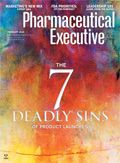Morgan Moments
Pharmaceutical Executive
The small biotech space-credited with ending the drought in new FDA drug approvals in recent years-takes center stage at this year's J.P. Morgan Investors Conference.
TO THE UNWARY, THE JANUARY J.P. MORGAN INVESTOR CONFERENCE in San Francisco bears resemblance to a predatory feast. Like spawning salmon, drugmakers fattened by great science nudge their forward-looking statements upstream-right into the jaws of grizzly investors seeking to score an easy meal. But the big message from this year's Morgan is that, for every start-up salmon caught, dozens more are now making it past the VC bears, propelled by a powerful current of innovation to secure their own destiny in the seed pools of specialty and oncology medicine.

William Looney
These smaller "stealth pharma" players, most with backgrounds in biotech, are finally beginning to show solid organic growth through focused therapeutics; diversity in the lab; and an intimate, grassroots connection to the patient. The result is what I call the "run of the breakthrough"-drug, of course. Innovative science is the driver, evidenced by the fact that many company presenters at Morgan were hard-pressed to distill all their promising trial data within the 20-plus minute time frames allowed under house rules. Such anecdotal evidence that science is back is bolstered by the latest stats from FDA, where 123 new drug applications (NDAs) were received for review by the agency in 2014, nearly three times the number posted for 2013.
In other words, the drought in FDA drug approvals during the tween years of the new millennium looks now to be over-and it's the small- to mid-size biopharma enterprise that is setting the trend. Of the 41 new drugs licensed by FDA last year, more than half (22) came from players outside the Big Pharma 10, bearing less than household names like Cubist, BioMarin, InterMune, and Amylin. Morgan thought leaders like Juno Therapeutics' CEO Hans Bishop tagged the prominence of smaller companies in the drug innovation ecosystem: while the relentless growth-in-revenue dynamic of big Pharma means they face distraction from having to pad their portfolios with follow-on drugs, start-ups, by definition, "have no choice but to focus on one new thing."
During Morgan, Pharm Exec took a closer look at the small biotech space, hosting a Jan. 14 Roundtable with nine US and European-based biotech CEOs. The science around the table was significant, covering unmet needs ranging from Parkinson-related psychosis and other CNS disorders to tumor suppression and antibiotic resistance. The business model of these companies is high risk because commercial advantage is sought in precisely those areas of science where big Pharma and the biotech majors have stumbled. To that end, we observed a lot of contrarian sentiment, along with an unrelenting focus on what's ahead. For example, now that the human genome has been parsed, our CEOs agreed that the inside advantage goes to those who can figure out how individual genes interact, not only as a precursor of disease but as a guide to cures.
Besides the "curse of anonymity" that comes from being small in an industry that values scale and reach, the biggest concern expressed by our Roundtable participants was the future of patient access. Surprisingly, this topic hardly surfaced in the larger discussions at Morgan. Applause for next gen PSCK-9 anti-cholesterol products and multiple new immunotherapies for cancer left no time for any clarifying dialogue on the billions of dollars insurers will have to pay for these large-population breakthroughs. It was left to George Paz, CEO of the largest US pharmacy benefit manager (PBM), Express Scripts, to suggest that the terms of engagement on market-bearing, no-questions-asked pricing and access were shifting nonetheless-and in his favor. Paz touted his PBM as a game-changing innovator-not "the middleman," a word he finds "irritating"-with a commitment to building drug plan designs that will, in the years ahead, efficiently take back many of those billions from the industry. Especially in the specialty/cancer segments, where more attention to moving script share toward the pharmacy [as opposed to the medical) benefit side, could slash spending growth rates "from the high teens to low single digits." Practicing physician oncologists, take note.
With all the talk about blossoming science, it was left to a few congenital cranks to note that new drug sales vs. the cost of capital is lower today than it was two decades ago. Yes, the economics are harsh and, sadly, therefore, the most pregnant question from Morgan was just not asked. If some of the best new science is from the small side of the industry, will innovation suffer when the race for patient access belongs to the biggest and the swift-those with the clout to match and give pause to the PBM?
You'll be able to read more about our biotech RT in our March issue.
William LooneyEditor-in-Chiefwlooney@advanstar.com Follow Bill on Twitter: @BillPharmExec

Navigating Distrust: Pharma in the Age of Social Media
February 18th 2025Ian Baer, Founder and CEO of Sooth, discusses how the growing distrust in social media will impact industry marketing strategies and the relationships between pharmaceutical companies and the patients they aim to serve. He also explains dark social, how to combat misinformation, closing the trust gap, and more.
FDA Grants Priority Review to Regeneron’s Eylea for Macular Edema Following Retinal Vein Occlusion
April 18th 2025Regulatory action was based on data from the Phase III QUASAR trial, which demonstrated that Eylea HD dosed every eight weeks achieved non-inferior visual acuity outcomes compared to Eylea in patients with macular edema following retinal vein occlusion.